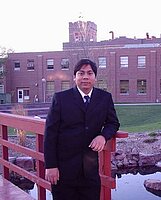Fractionation of Natural Organic Matter in Water from the Red River and the Moorhead Water Treatment Plant, Minnesota Using a Novel Solid Phase Extraction Technique

Thunyalux Ratpukdi is a Ph.D. candidate in Civil Engineering Department from North Dakota State University. He received Bachelor of Engineering in environmental engineering at King Mongkut’s University of Technology Thonburi (KMUTT), Bangkok, Thailand and M.S. degree in environmental management at Chulalongkorn University, Bangkok, Thailand. He is currently working on Fractionation of Natural Organic Matter in Water from the Red River and the Moorhead Water Treatment Plant, Minnesota Using a Novel Solid Phase Extraction Technique
Email:Thunyalux.Ratpukdi@ndsu.edu
Fellow: Thunyalux Ratpukdi
Advisor: Eakalak Khan, Ph.D., Associate Professor, Department of Civil Engineering, North Dakota State University
Degree Progress: Ph.D. in Environmental Engineering expected in May 2008.
Fractionation of Natural Organic Matter in Water from the Red River and the Moorhead Water Treatment Plant, Minnesota Using a Novel Solid Phase Extraction Technique
In the drinking water field, the presence of Natural organic matter (NOM) is a concern because it can cause several impacts on water quality and treatment processes. The reactivity of NOM is closely related to its physicochemical properties such as molecular weight, aromaticity, elemental composition, and functional group content. However, it is not well understood due to heterogeneous properties of bulk NOM. To overcome the complexity of NOM, isolation or fractionation is often required in order to obtain more uniform material for further characterization as well as to provide the link between NOM properties and its behavior when subjected to treatment processes.
Recently, I have developed a new NOM fractionation procedure using pre-packed solid phase extraction (SPE) sorbents to fractionate NOM into six fractions includes hydrophobic acid, hydrophobic base, hydrophobic neutral, hydrophilic acid, hydrophilic base, and hydrophilic neutral. With this novel technique, the fractionation time could be reduced to about 6 hours (compared to 24 hours for existing technique).
The Moorhead Water Treatment Plant (MWTP) uses the Red River water as a primary source to produce drinking water for residents of city of Moorhead, MN. Understanding the characteristic and composition of NOM in the drinking water source is helpful for the identification the problematic NOM fractions (the NOM fractions that have potential to form carcinogenic disinfection byproducts). Currently, fractionation and characterization NOM from the Red River never been investigated. Total organic carbon (TOC) is used to measure performance of NOM removal at different treatment stages at MWTP. However, the TOC values of bulk water can only indicate the organic content but do not provide information on the treatability of the different types of organic molecules in NOM. NOM fractionation technique could elucidate the effect of water treatment processes at MWTP on NOM composition.
Project objectives:
The main scope of this study is to fractionate and characterize NOM from the Red River and to investigate the removal of each NOM fraction along the treatment train of MWTP. The specific objectives of the study are as follows:
- To fractionate NOM in water from the Red River;
- To characterize the isolated NOM fractions by nuclear magnetic resonance (NMR), Fourier transform infrared spectroscopy (FTIR).
- To investigate the effect of water treatment processes at MWTP on NOM composition.
Progress:
NOM from the Red River has been fractionated and characterized. The Effect of treatment processes at MWTP on NOM composition has been investigated. This study is close to completion.
Significance:
For the first time, the application of the novel SPE technique will be demonstrated and NOM in the Red River water will be fractionated. The fate of different NOM fractions through the treatment train of MWTP will be elucidated. Deliverables from this project include the information on the composition and characteristics of NOM in the Red River water and the efficiency of treatment units at MWTP for removal of NOM fractions.

Eakalak Khan
Civil & Environmental Engineering
NDSU


